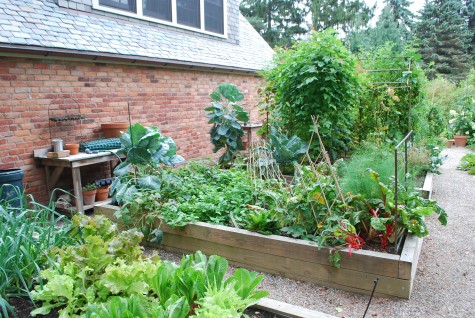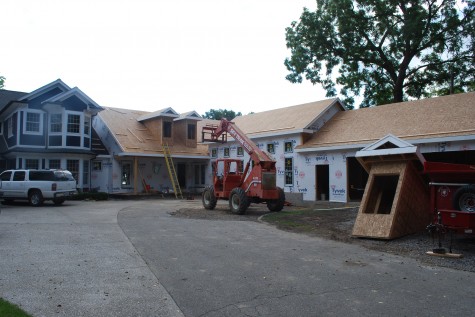 I do not grow vegetables at home. In my opinion, a vegetable patch looks messy and disorganized, even when it is anything but. Working gardens show evidence of that work. I am not interested looking at work when I go home-I have already done that all day long. Afficianados of growing food at home like Lolo are a hard working lot that have an astonishing range of knowledge. Growing from seed, pairing plants, crop rotation-the depth of her knowledge is impressive. Often there is a family history that includes growing food, cooking, family meals that is a way of life. I would want a working garden to be beautiful in a way it cannot be. Sooner or later, every vegetable garden tends towards dissolution.
I do not grow vegetables at home. In my opinion, a vegetable patch looks messy and disorganized, even when it is anything but. Working gardens show evidence of that work. I am not interested looking at work when I go home-I have already done that all day long. Afficianados of growing food at home like Lolo are a hard working lot that have an astonishing range of knowledge. Growing from seed, pairing plants, crop rotation-the depth of her knowledge is impressive. Often there is a family history that includes growing food, cooking, family meals that is a way of life. I would want a working garden to be beautiful in a way it cannot be. Sooner or later, every vegetable garden tends towards dissolution.
 The vegetable garden can be designed in a very orderly way. Raised beds permit making choices about soil composition. There can be the designated asparagus, strawberry or raspberry patch. Espaliered fruit trees, grapes, and a fig tree can be worked into the design. A spot to grow cutting flowers-what a great idea. But once I get to this point, I am not only over my head, but I have lost interest as I have lost control. Fortunately most people who would devote part of their landscape to seriously growing food know what they need from a space. Cultivating a vegetable garden is not for a weekend gardener-it is an every day committment.
The vegetable garden can be designed in a very orderly way. Raised beds permit making choices about soil composition. There can be the designated asparagus, strawberry or raspberry patch. Espaliered fruit trees, grapes, and a fig tree can be worked into the design. A spot to grow cutting flowers-what a great idea. But once I get to this point, I am not only over my head, but I have lost interest as I have lost control. Fortunately most people who would devote part of their landscape to seriously growing food know what they need from a space. Cultivating a vegetable garden is not for a weekend gardener-it is an every day committment.
When the soil-making and daily tending and growing has been good, it seems like there is that moment when the the entire garden seems poised to overrun the space. The paths get narrower; the squash has grown out of the box and heads for the road. Is there a vegetable plant that does not not fall over in a heap? I have yet to see a vegetable garden not overrun with withies, stakes, towers, arbors and cages.
 The potting bench surface is usually covered with tools, packets of seeds, a collection basket, the soil sifter, and the like. Vegetable people leave their hoses, stakes, Japanese beetle collecting cans and gloves out in plain sight-why wouldn’t they?
The potting bench surface is usually covered with tools, packets of seeds, a collection basket, the soil sifter, and the like. Vegetable people leave their hoses, stakes, Japanese beetle collecting cans and gloves out in plain sight-why wouldn’t they?
 Every plant is at a different stage. The pea patch runs out and has to be replanted-as do the lettuces, spinach and radishes. There are those bare dirt spaces hosting the seeds of the next crop. The galvanized wire hats goes over what ever is being eaten by the birds, rabbits, deer, raccoons and woodchucks at that moment.
Every plant is at a different stage. The pea patch runs out and has to be replanted-as do the lettuces, spinach and radishes. There are those bare dirt spaces hosting the seeds of the next crop. The galvanized wire hats goes over what ever is being eaten by the birds, rabbits, deer, raccoons and woodchucks at that moment.
 All in all, a vegetable garden at harvest time is a gloriously messy affair. Never mind the work that is involved enlisting the help of others when the garden bears vastly more than what you can eat. Is there any more ungainly looking plant on the planet than the brussel sprout plant? I do understand that home grown food is the best food there is-I have been the lucky recipient of various harvest overruns. I love OPVG’s-other people’s vegetable gardens.
All in all, a vegetable garden at harvest time is a gloriously messy affair. Never mind the work that is involved enlisting the help of others when the garden bears vastly more than what you can eat. Is there any more ungainly looking plant on the planet than the brussel sprout plant? I do understand that home grown food is the best food there is-I have been the lucky recipient of various harvest overruns. I love OPVG’s-other people’s vegetable gardens.
 This tomato in articular whose name I do not know is incredibly great looking, and great tasting. The bush on which it grows-not so pretty. It seems as though tomatoes and tomato plants are as irresistable to bugs, fungus and disease as they are to me. Who wants to look at hornworms, flea beetles, and cut worms? Who wants to deal with early blight, gray wall, catfacing or blossom end rot? Who wants to read the Texas A and M tomato disorder page?
This tomato in articular whose name I do not know is incredibly great looking, and great tasting. The bush on which it grows-not so pretty. It seems as though tomatoes and tomato plants are as irresistable to bugs, fungus and disease as they are to me. Who wants to look at hornworms, flea beetles, and cut worms? Who wants to deal with early blight, gray wall, catfacing or blossom end rot? Who wants to read the Texas A and M tomato disorder page?
 Who really wants to look at this at the end of a season? My theory is that vegetable plants give so much for so long, they finally succumb to every fungus and illness swirling around in the air and soil. I am grateful to have both friends and clients who deal with all of this and more-otherwise I would never eat any home grown food.
Who really wants to look at this at the end of a season? My theory is that vegetable plants give so much for so long, they finally succumb to every fungus and illness swirling around in the air and soil. I am grateful to have both friends and clients who deal with all of this and more-otherwise I would never eat any home grown food.
Anyone who grows vegetables, fruits and herbs at home has the idea in their mind that fresh and pure is delicious and good for them, and their family. What other reason could there be that would motivate them to work so hard, day after day? They, like Lolo, are gardeners of the most serious sort.





















